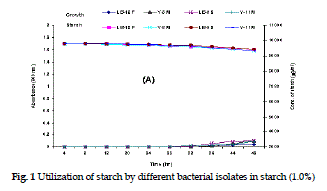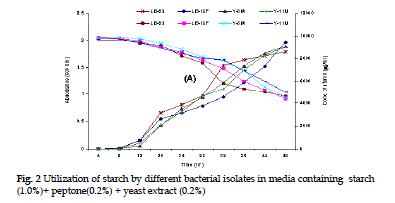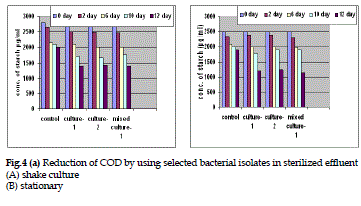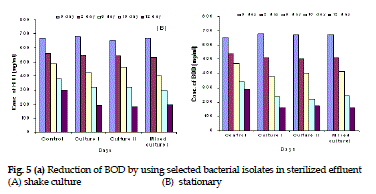Keywords
|
| Bioremediation, Sella-rice plant effluent, BOD, COD. |
INTRODUCTION
|
| Paddy one of the most important crops of the world is the prime cereal crop that is cultivated in India in an area of 42 million hectares. Annual production of paddy is 76 million tones and it constitutes approximately 42% of India is food grain production (Rao, 2003). A major part of total paddy produced is converted into ‘Sella’ or parboited rice. Parboiling is a premilling process for paddy that originated in India (Subrahamanyan, 1971). It involves hot water treatment of paddy at 60-700C for 3-3.5 h (Paspia and Desikachar, 1980). After soaking, the water is drained that has high BOD, COD and organic contents. The effluent is generated @ 900-1000 litres for each tones of paddy processed. According to water pollution control and Prevention Act, 1974, the Sella-rice plant effluent can not be disposed without treatment. However, in general most of the Sella producing units dispose effluent in water bodies at cultivated lands after 5 to 10 times diluted with water, which involves a high quality of water and costly transport facilities. |
| Because industrial effluents have on adverse impact on soil health and agriculture they need to be treated by physical, chemical of microbiological techniques. Among these methods microbiological treatment is not only cheap and easy but also ecofriendly. Effluents from distillery, tannery, textile and paper industries have been treated with bacteria and fungi (Hernandez et al. 1994; Singh et al. 1995; Srivastava and Thakur, 2003 and Kuhad et al. 2004) prior to disposal. However, no such information is available with regard to treatment of Sella-rice plant effluent. A study thus was conducted to determine the conditions required for growth of microorganism on Sella-rice effluent for its bioremediation. |
MATERIALS AND METHODS
|
| Collection of samples - The samples of Sella-rice effluents were collected from 3 different location in Haryana i.e. Jind, Fatehabad and Yamunanagar in presterilized glass bottles for microbiological analysis. |
| Isolation of starch utilizing bacteria - Microorganisms were isolated from effluent on 3 different types of media viz. LB, YEPDA and PDA by enrichment culture technique. Further all the selected isolate were studied in starch both (1.0% supplemented with peptone (0.2%) and yeast extract (0.2%) for determination of starch (Malik and Singh, 1980) and growth at different time intervals under shaker conditions. The inoculated flasks were incubated at 300C on rotary shaker for 48 h. The samples (10 mL) were withdrawn at different time intervals upto 48 h, centrifuged the samples of each isolates was taken for estimation of starch and pellets were resuspended in sterile distilled water and absorbance was measured at 600 nm. |
| Bioremediation process - The bioremediation of Sella-rice effluent was examined under laboratory conditions by using selected bacterial isolates under shaker as well as stationary condition at temperature 300C. |
ResultS and Discussion
|
| Microorganism were isolated from Sella-rice effluents by enrichment culture technique. A total number of 130 isolates were obtained from effluent samples collected from 3 location on 3 different media. These isolates were further characterized for cultural and morphological characteristics. Out of 130 isolates only 8 were able to utilized starch as a source of carbon in presence of peptone (0.2%) and yeast extract (0.2%) Fig. 1 depicts the grown and utilization of starch by 4 isolates. However, none of the isolates showed slow grown as utilization of starch. Addition of nutrients such as peptone and yeast extract improved the utilization of starch (Fig. 2) by isolates. The concentration of starch decreased from 9900 mg/mL to 3500 mg/mL when isolates LB-9S, LB-18 F and Y-11 M were used growth were also fasts. |
| The experiment was conducted for bioremediation of effluent using sterilized as well as unsterilized sella-rice effluent in presence of bacterial isolates (individually as well as mixed culture) under stationary and shaker condition (Fig. 3a to 5b). It was found that with the inoculation of different isolates not only amount of starch decreased but BOD and COD also decreased with in 12 days at incubation. The amount of starch was reduced (Fig. 3a) from 650 to 140 mg/mL after 12 days of incubation in sterilized effluent on rotary shaker in comparison to unsterlized effluent. Likewise, COD (Fig. 4a) was also reduced from 2500 to 1200 mg/L and BOD (Fig. 5a) from 650 to 160 mg/L by using selected bacterial isolated inoculated in sterilized effluent on shaker condition. The odour and colour of the treated effluent were found to be pleasant and light yellow colour is comparison to control that possessed foul smell and dark colour. Thus, these culture can be efficiently used for bioremediation of Sella-rice effluent. |
Conclusion
|
| The samples of effluent were collected from 3 Sella-rice plants located in Haryana. Total numbers of 13 isolates were characterized. Only 4 isolates were show maximum utilization of starch in presence of peptone (0.1%) and yeast extract (0.1%). The effluent was treated under laboratory conditions using selected bacterial isolates (individual as well as mixed culture) for rapid bioremediation. These bacterial isolates can be exploited to develop a bioremediation process to reduce starch, BOD and COD of Sella-rice effluent. |
Figures at a glance
|
 |
 |
 |
 |
 |
| Figure 1 |
Figure 2 |
Figure 3 |
Figure 4 |
Figure 5 |
|
References
|
- Hernadez, M., Rodriguez, J., Soliveri, J., Perez, M.I. and Arias, M.E. 1994. Paper milleffluent decolourization by fifty Streptomyces stains. Appl. Environ. Microbiol.60 : 3909-3913.
- Kuhad, R.C., Sood, N., Tripathi, K.K., Singh, A. and Ward, O.P. 2004. Developmentsin microbial methods for the treatment of dye effluents. Adv. Appl. Microbiol.56 : 185-213.
- Malik, C.P. and Singh, M.B. 1980. Plant Enzymology and Histoenzmology. Kalyani Publishers,New Delhi.
- Paspia, H.A.B. and Desikachar, H.S.R. 1980. Modern process for parboiling of rice. J.Fd. Sci. Technol. 18: 84-89.
- Rao, C.P. 2003. Nutrient utilization efficiency of rice influenced by different sourcesand levels of phosphorus and rates of zinc. Annals Agri. Res. 24 (1) : 7-11.
- Shrivastava, S. and Thakur, I.S. 2003. Bioabsorption potential of Acinetobactersp. StrainIST 103 of bacterial consortium for removal of chromium from tannery effluent.J. Sci. Ind. Res. 62 : 616-622.
- Singh, D., Dahiya, J.S., Nigam, P. and Marchant, R. 1995. Decolourization of molasseswastewater by Pseudomonas fluorescens. Gene. 60 : 2253.
- Subrahmanyan, V. 1971. Recent advances in rice processing. J. Sci. Ind. Res. 30 (12) :729-731.
|